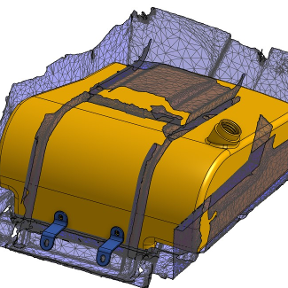Welcome to the Onshape forum! Ask questions and join in the discussions about everything Onshape.
First time visiting? Here are some places to start:- Looking for a certain topic? Check out the categories filter or use Search (upper right).
- Need support? Ask a question to our Community Support category.
- Please submit support tickets for bugs but you can request improvements in the Product Feedback category.
- Be respectful, on topic and if you see a problem, Flag it.
If you would like to contact our Community Manager personally, feel free to send a private message or an email.
Best Of
Re: Improvements to Onshape - January 31st, 2025
Actually it was related to tracking protection. They work on Standard but I apparently had it on Strict.
Re: Large tile layout challenge
The add option in all feature creation tools simply requires parts to be touching and not necessarily intersecting.The edges of your Asher base pattern are missing half the grout to complete that pattern and allow that add function to do its thing. I may play with your file for my own study and share it to demonstrate some "cleaner" ways to do what you need next time.
In Revit you can explore those mitered areas with ease. I'm not familiar with chief architect.. It would not be a 3d visual of a tile/grount pattern but it would get the job done with a 2d pattern filling any surface you need it to with the ability to move and rotate the pattern as you see fit.
Did some performance testing on your file and discovered a significant performance hit when using a 2nd direction with the pattern part add feature. There's about a 200% hit in performance of that feature vs just using 2 separate part pattern adds. Only tested using your file. I'm interested to see if its consistent, and if so that's definitely something to be mindful of
 MDesign
MDesign
Re: What does Onshape have against the numbers 0,4,6,8,9 and the letters A,B,D,O,P,Q and sometimes R
Thanks!
How do I learn how to use the Sheet Metal features?
We don't do a lot of sheet metal, but we do a lot of bent Lexan, and it would be nice to leverage the sheet metal tools to make our parts.
But everything we try and do seems confusing, frustrating, and unintuitive. We'd like to learn more, but there doesn't seem to be an official tutorial on the whole sheet metal methodology.
How can I learn how to use it?
There's basically nothing useful here: https://learn.onshape.com/catalog?query=sheet%20metal
This was a recent part, modeled traditionally, then offset surface > convert to SM just to get it laid flat for CNC.
Re: Assembly Planes - Where are they?
I believe mate connectors are essentially your assembly planes
 MDesign
MDesign
Re: API for beginners
For anyone stumbling on this post (I'm an external developer and not part of Onshape):
Internally Onshape has data models of the features.
When a API REST response is returned, it contains the model of the feature.
The data model of a feature includes (but is not limited to):
- The feature data required to generate it using featurescript, the param is
feature - The parameters for the feature itself
parameters - The type of feature
btType - Conditional: The dependent features to generate the feature
featureIds
I've attached a POSTman collection below. Read the comments carefully and it should generate sketches, fillets, extrudes
(The collection does not include documentation on how to authenticate)
The most important nugget of information is the queryString in step 11 (create mirror). It contains a query that returns an entity from a feature id. This should give you enough tools to use the API in combination with feature script queries to completely generate features in Onshape.
Re: CNC tube bending Drawing
Im one of the developers on the Frames featureset. I'd love to hear more about a) what you need b) what your tube suppliers need c) what you have liked/disliked about other CAD and CAM packages doing similar things. I would have characterized this as a CAM need rather than a CAD need -- but I'd much rather hear from customers than relying on my own wrong conclusions! Could I ask you both for a favor? Please file this with support (same process as creating a ticket). Discussing on the forums is great and I want to encourage it but generating that improvement request starts the paper trail the product and dev teams need to start design and scoping discussions.
Re: Complete beginner
Since Nick has the question already handled, here is some more useful info for new users:
Try the Learning Pathways. They will take you completely from beginner to advanced Onshape user.
Re: Complete beginner
Use the symmetric constraint to make the top and bottom lines of the rectangle symmetric about the front plane.
The tutorial you followed "probably" used the center-point rectangle, and aligned the center point with the origin. Right now you have the tangent of one of the circles aligned with the origin.
Also your circles are all construction lines. If you want to make a board with holes, change them to solid lines. Click the circle and press the Q key to do that.
Re: dimensioning
Also - you can quickly create variables "on the fly" without leaving the sketcher. As soon as you create a variable, it's placed above the Sketch you're working on in the Feature List - and becomes available right away to use in the same Sketch!
So, you could double-click on the "50" dimension, start typing a name - (sometimes for this I'll use a simple "a" or "a1" designation for the variable - that way I don't have to think of a perfect meaningful name while I'm in the sketcher) - create your variable "#a = 50". Then you can immediately double-click on the "18" and use your #a variable: "#a-32" or whatever.
You could choose to rename those variables later so you don't get confused - maybe "sketch1_a" or something.
You'll find that variables are super useful in many workflows and to capture design intent. You may find that you want to move that "50" variable to the top of your Feature List and reference it all over the place!








